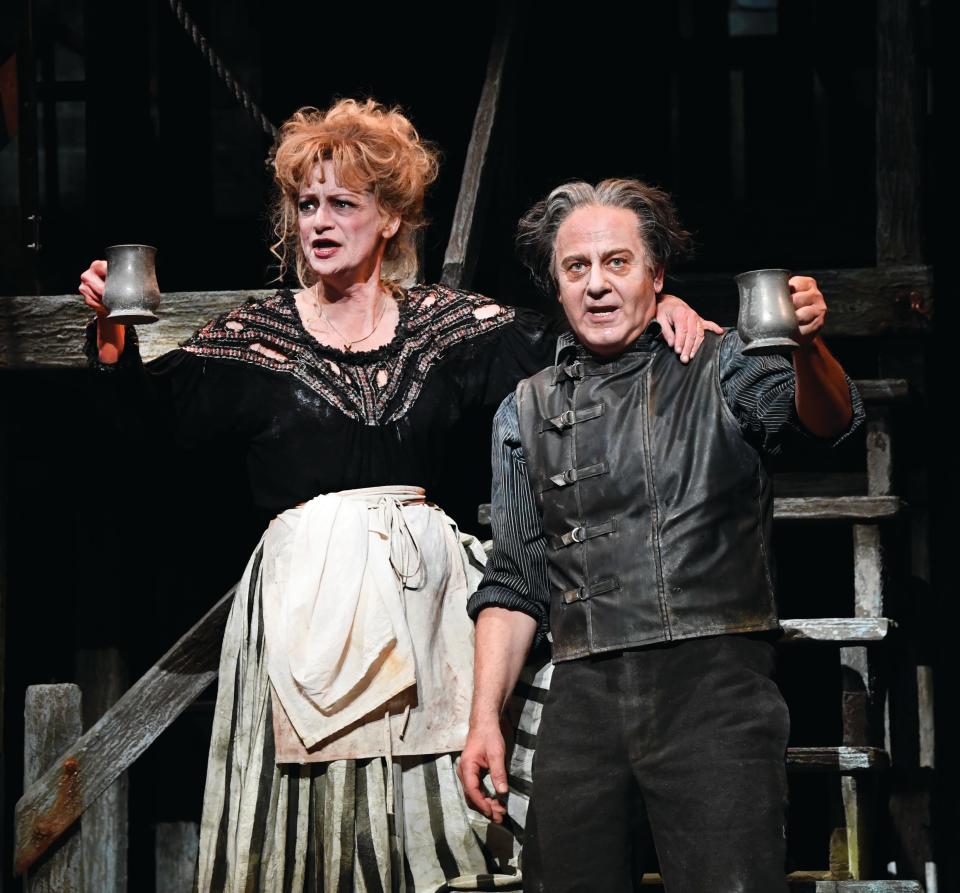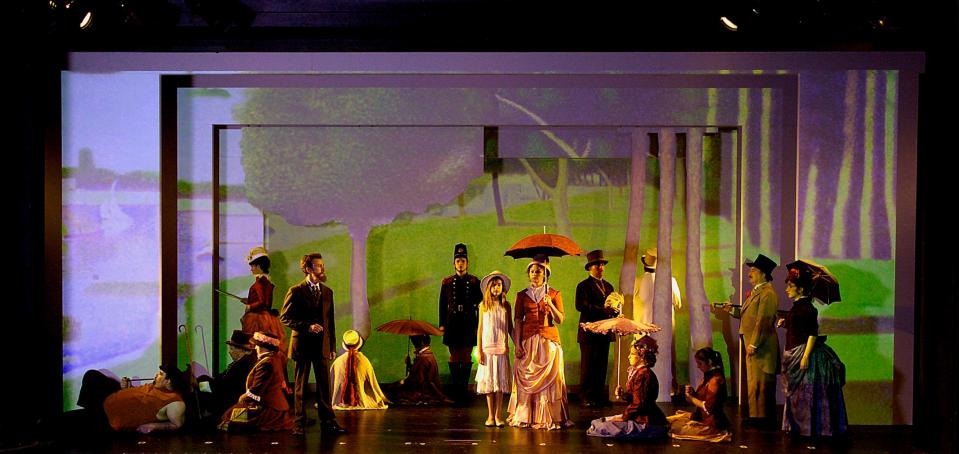Cherishing a lifetime of musical theater created by Stephen Sondheim
- Oops!Something went wrong.Please try again later.
- Oops!Something went wrong.Please try again later.
- Oops!Something went wrong.Please try again later.
In 1988, Asolo Repertory Theatre opened its season with the musical revue “Side by Side by Sondheim,” featuring songs written by Stephen Sondheim through the mid-1970s. I sent him a typewritten letter asking for an interview to share with readers.
In a brief reply, he declined by saying, “I’m avoiding all interviews and extracurricular activities until I finish the show I’m working on.” And he signed it “Apologetically, Stephen Sondheim.”
It would have been great to talk to him about his creative process, but I’m happy just to appreciate and write about the results.

I have been overwhelmed reading all the tributes to Sondheim and his impact on the world of musical theater since his passing at age 91 on Nov. 26. Just two months ago he was touting a new show, “Square One,” he was working on with playwright David Ives that he hoped would be staged in the coming year. And just six months ago, my friend and colleague Rick Pender published his authoritative “The Stephen Sondheim Encyclopedia.”
Arts Newsletter: Sign up to receive the latest news on the Sarasota area arts scene every Monday
Six degrees of John Ringling: Tracing the roots of Sarasota’s arts and culture explosion
Sondheim’s shows were not always hits – for years he was criticized as being cold and dispassionate – but he changed how we perceived the possibilities of musical theater, which is why his death has had such an impact on so many.

With writer George Furth and director Harold Prince, he helped invent the idea of the “concept musical” with “Company,” which was about marriage and commitment told through vignettes. Each show, from “Follies” to “Pacific Overtures” to “Sweeney Todd” and beyond took us into different worlds, styles and thoughts.
Holiday traditions on stage: Where to find Nutcrackers, Christmas Carols and holiday favorites in Sarasota-Manatee
From Bikini Bottom: ‘SpongeBob the Musical’ brings favorite cartoon characters to Sarasota stage
I was one of the lucky few who got to see the short Broadway run of the troubled musical “Merrily We Roll Along,” which features one of his liveliest and most engaging scores. I wish Furth’s book, which is based on a 1934 play by George S. Kaufman and Moss Hart and tells its story backwards in time, matched the quality of the music. I saw an early preview of “Passion” during which audience members were laughing when they should have been moved. I saw it again a few weeks later and it was a musical transformed with beautifully rendered emotional peaks and valleys.

Getting to the point of creativity
But it was his 1984 musical “Sunday in the Park with George,” written with director and writer James Lapine, that forever burnished his work in my heart, mind and gut. The musical tells a story about pointillist artist Georges Seurat creating his most famous painting “A Sunday Afternoon on the Island of La Grande Jatte.” It is mostly fiction, but a searing portrait of the creative mind at work.
Over the course of the first act, Seurat has been ridiculed by colleagues, criticized by the figures in the painting for how they are depicted and dumped by his girlfriend, who demands more attention than he can give her.
Finally, as the act concludes, all the people come together with the grass, parasols and monkeys and sing “Sunday,” one of the most melodic and inspiring songs in his large cannon. As the orchestra hits its final notes, a large frame drops capturing the image we know today.
When I saw the show on Broadway and that painting came together, I sat with my friends throughout the intermission, too stunned and overwhelmed by what we had just seen and heard to move or say much more than “that was amazing.”
It is one of the top theatrical memories of my life and one that I have been able to relive a few times in other productions, most notably the wonderful production that Rick Kerby staged for the Manatee Players in 2010.
The way Seurat paid such close attention to how dots of color would merge in the eye to create a fuller picture mirrors the way Sondheim himself worked. He details some of his process in his highly recommended two-volume collection of his lyrics, “Finishing the Hat” and “Look, I Made a Hat.”
Just a few days before Sondheim’s death, I finished Lapine’s wonderful new book “Putting it Together: How Stephen Sondheim and I Created ‘Sunday in the Park With George’,” in which he details the difficulty in getting all the musical’s dots to fit together. Audiences fled early previews in droves because the second act wasn’t finished until just a day or two before opening night.

A musical world of discovery
About 30 years ago, I spent a month as a fellow at the National Critics Institute in Waterford, Connecticut, where one of our teachers, the critic Dan Sullivan, led a workshop in which he played several versions of the “Follies” song “Losing My Mind” performed by different singers.
The session expanded my understanding of how different artists can interpret a single piece of music. I have tried the exercise with participants in other classes and workshops I have led and I continue to learn from it and hear new things each time. There are now so many versions you could probably study that one song for a semester in a college course.
The song is performed by a former follies girl singing about a man from her past who is forever in her mind, at least as she imagined him.
Sondheim is unique in his ability to write songs that challenge both the artists singing them and the audiences hearing them to discover new things each time they are performed. I have lost count of how many actors I’ve heard sing “Send in the Clowns” from “A Little Night Music” and each time I think I understand it in a different way. (Judi Dench’s version from a National Theatre is among my favorites.)
The more you hear, the more you can appreciate the structure and wit of his lyrics. I have always loved a line in the title song from “Into the Woods.” Jack’s mother is encouraging her son to sell their aging cow and sings: “We’ve no time to sit and dither while her withers wither with her.” I had to look up the meaning of “withers.”
That’s why his music never gets tiresome. There are plenty of theater composers whose work I love, but the songs become almost too familiar. Sondheim’s work forces you to listen (in the best ways) and remains vibrant and alive with each new performance.
I’m not sure how far Sondheim got with “Square One” or how many songs may be sitting in a trunk somewhere. Surely, there is more than we know about. Maybe, we’ll get to hear them in a show or a recording.
Still, his shows will carry on. “Company” has returned to Broadway, a new film of “West Side Story” is out in December and an off-Broadway revival of “Assassins” is running.
But even if there is never another Sondheim show, we will have the joy of rediscovering all that he created and how these shows speak to us in different ways as we go through life.
Follow Jay Handelman on Facebook, Instagram and Twitter. Contact him at jay.handelman@heraldtribune.com. And please support local journalism by subscribing to the Herald-Tribune.
This article originally appeared on Sarasota Herald-Tribune: Stephen Sondheim left us music, Broadway shows to cherish for lifetime

